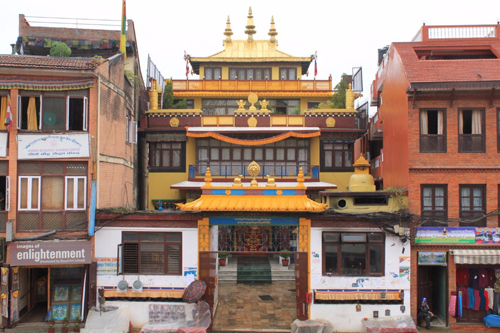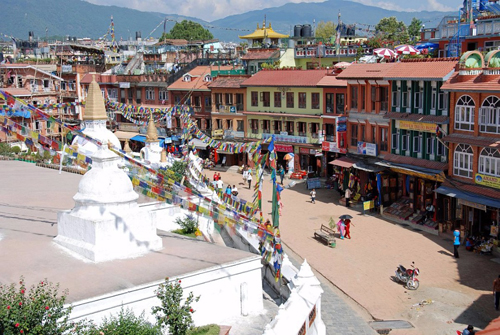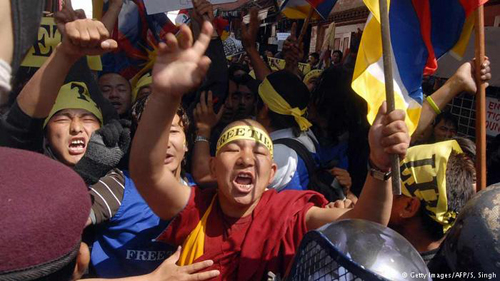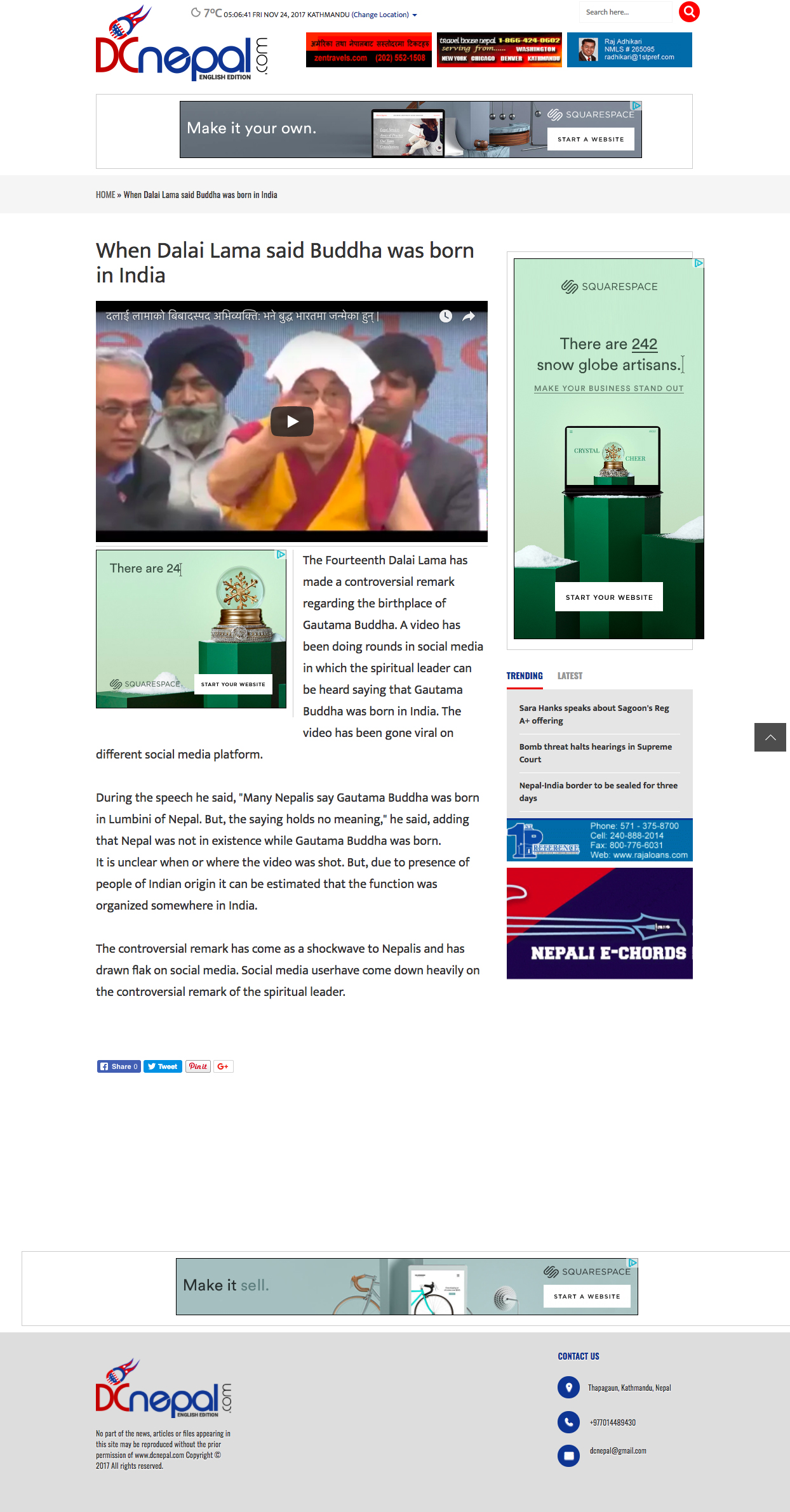There are four places of pilgrimage that are considered a must-visit for all Buddhist practitioners of all traditions. One of these places is the Buddha’s birthplace in Lumbini in present-day Nepal. In 245 BC, Emperor Ashoka confirmed the location of Buddha’s birth by erecting a pillar with inscriptions attesting to this; today, this monument is a UNESCO World Heritage Site famously known as the Ashoka Pillar.
The Buddha’s birthplace being in Lumbini is something that the Nepali people are fiercely proud of. They celebrate Buddha Jayanti (the birth anniversary of the historic Buddha) on May 21st every year and it is a hallowed tradition regarded as sacred by this Himalayan nation. Thousands from all over the world fly to Lumbini to join in the festivities.
But all of this is mere nonsense according to the 14th Dalai Lama. In recently-released footage on Rajdhani TV, the Tibetan spiritual leader dismissed this historic fact in a manner that was very demeaning to Nepal. The dismissal was all the more galling considering Nepal has been very kind to the Tibetan people, having hosted a huge Tibetan refugee community for over 60 years.
This is a point the Dalai Lama appears to have missed or does not care too much about, and his statement is very disrespectful and harmful for a number of reasons:
- Nepal, despite struggling with its own issues, has shown so much generosity to Tibetans by hosting some 30,000 to 40,000 refugees. This amounts to roughly a third of the Tibetan diaspora, and they are housed in 12 Tibetan refugee camps throughout Nepal. Tibetans who arrived in Nepal before 1989 benefited tremendously from the country’s economic and social integration. Many Tibetans opened businesses, shops and restaurants that are patronized by hordes of tourists who visit Nepal every year. In Nepal, they were also able to re-establish their Tibetan monasteries. Hence it would not be mistaken to say that Nepal contributed greatly to the survival of the Tibetan identity and tradition. And yet, this is how the Tibetan leadership repays them, by dismissing one of their beloved beliefs and sources of national pride.

Since they first entered exile through the China-Nepal border in 1959, Tibetan refugees in Nepal have done extremely well for themselves. Amidst aging Nepali homes rise large golden-roofed temples which are as richly decorated inside as they are outside. After the 2015 earthquake in Nepal, the Tibetan temples were often the first to be rebuilt, thanks to donations from all over the world. Meanwhile the Nepali people continued to languish outdoors in the elements for months, before receiving more permanent shelter. It was also during this time that some of the Dalai Lama’s associates were found to have been raising money on the pretext of donating to earthquake victims, but keeping the money for themselves instead.
- The Dalai Lama’s statement is very harmful to the Nepali economy. Spiritual tourism is one of the largest industries in Nepal, and it is an important source of foreign exchange and revenue, drawn no doubt by sacred sites like Lumbini. The Tibetan refugees themselves also rely on the Nepali tourist industry to draw customers to their various businesses. Therefore when the Dalai Lama makes baseless statements like this, it undermines the credibility of Nepal’s spiritual tourism. Many people in the world assume that the Dalai Lama is the head of the Buddhist religion and the supreme authority of all matters Buddhist, and therefore he must be correct about this. In the end, it is Nepal that will lose out because the assumption is, if the Dalai Lama himself said so, then Nepal’s claim to be the Buddha’s birth country must be a fraudulent statement.
- In fact, the Dalai Lama and his government, the Central Tibetan Administration (CTA which is based in Dharamsala) has shown little interest in the well-being of the Nepalis. Even during the recent earthquakes which devastated Nepal, the CTA merely issued a simple statement expressing sorrow, offered 20 lakh rupees (equivalent to less than USD 32,000) towards Nepali rescue and relief efforts, and promised to pray for Nepal. This is a pittance compared to the countless millions that the CTA receives annually in government grants, public aid and donations. In fact, while the CTA was offering this pittance, some of the Dalai Lama’s associates used the Nepal earthquake to raise funds for the victims, but failed to disburse the money to anyone. Their bank accounts were later frozen on charges of money laundering. It shows clearly that the Tibetan government is only interested in what it can gain from its friends and does not bother much with how it can contribute to the people of other nations.

Some of the Tibetan shops surrounding the world-famous Boudhanath Stupa. Thousands of tourists visit this UNESCO World Heritage Site every day, and patronize the many wealthy Tibetan businesses there. Tensions have been rising in recent years against Tibetan refugees, who are accused of taking the best business spots and pricing out the local Nepalis.
- The Dalai Lama’s statement reignites a long-standing spat between India and Nepal over the right to claim to be the Buddha’s birth country. It was completely unnecessary for the Dalai Lama to raise this issue and reopen old wounds, especially when the spiritual leader owes a debt of gratitude to both India and Nepal. It also shows very poor diplomacy skills especially at a time when China is openly wooing Nepal with trade and the construction of important infrastructure. Angering the Nepalis in this way will only push them further into the arms of China, from whom they can benefit greatly by opening trade relationships. Ultimately, it shows that the Tibetan people are ungrateful and disrespectful even after half a century of contributions and support from Nepal.
Conclusion
The Nepali nation has every right to be upset. The Dalai Lama being an elder statesman and a senior religious figure synonymous with wisdom and kindness must be fully aware of the power of his words. He is one of the most visible personalities in the world and, rightly or wrongly, a trusted public figure. Everyone has seen how the Dalai Lama has destroyed centuries-old spiritual traditions like the Dorje Shugden practice by simply declaring it to be demon worship, without furnishing any proof or explanations. Now, the same disregard is shown to the Nepali people.
There cannot be any justification why the Tibetan leadership would inflict this blow on the nation of Nepal. The anger of the Nepali people towards the Dalai Lama’s statement is justified. They have been very generous and tolerant towards the Tibetan refugees; the least that the Tibetan leadership could do is respect their history and culture.

Every year, Tibetan refugees in Nepal launch protests against the Chinese government, forcing the Nepali police to allocate already-strained resources into policing them. These protests have a negative impact on Nepal’s relationship with China. Is this how Tibetan refugees show gratitude to their Nepali hosts, by adversely affecting their host country’s economy and relationship with other nations, and their ability to provide for their own local people?
It would behoove the Tibetan leadership to practice greater sensitivity towards the Nepalis in the future as the people are already very upset. Unlike the many other groups that the Tibetan leadership has insulted and maligned, there is much that the Nepali government can do in retaliation. For example, the CTA may now lose another one of their strong allies in the Himalayan region. China is already extending a hand of friendship to Nepal and now, due to the Dalai Lama’s statement, the Nepali government has just been reminded that cultivating a relationship with the Tibetans will not benefit their country or people. The only result will be more grief, insults and violence.
In contrast, a relationship with the Chinese will result in financial and trade benefits for the nation, as well as infrastructure improvements and economic growth. The CTA also fails to recall that the presence of Tibetan refugees in the country is totally reliant on the Nepali government’s continued patronage; without their support, the Tibetans could be asked to leave any day. How much longer can the CTA rely on the kindness of others, while they simultaneously insult and anger them? How much longer can the CTA survive in this way? At the rate they are going, the obvious answer is ‘not much longer’.
The Nepali Reaction
This is how the Nepalis are responding to the Dalai Lama’s statement that Buddha was born in India, and not Nepal. The Nepalis, as you can see, are extremely upset and are making their unhappiness known in official news channels as well as online on social media platforms. Videos of the Dalai Lama’s statement are also circulating and being shared widely. You can see below the numerous examples of the Nepalis’ reaction, and the strength of feeling that the normally peaceful people of this nation currently have against the Tibetan leadership and the Dalai Lama himself.

Click to read the full report

Click to read the full report

Click to enlarge

Click to enlarge

Click to enlarge

Click to enlarge

Click to enlarge
All Reactions
MORE NEWS LIKE THIS